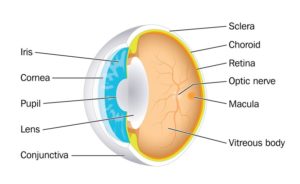What is ARMD?
Age-related macular degeneration is a leading cause of vision loss for people over 50, making it an extremely common eye condition.
 Basically, the macula is tiny and the most sensitive part of the retina and its job is to keep our central vision sharp and accurate. The retina is a thin layer of tissue that lines the back of the inside of the eye, near the optic nerve. The optic nerve connects the eye to the brain. The retina turns light into electrical signals and then sends these electrical signals through the optic nerve, where the brain translates them into the images we see.
Basically, the macula is tiny and the most sensitive part of the retina and its job is to keep our central vision sharp and accurate. The retina is a thin layer of tissue that lines the back of the inside of the eye, near the optic nerve. The optic nerve connects the eye to the brain. The retina turns light into electrical signals and then sends these electrical signals through the optic nerve, where the brain translates them into the images we see.
Age-related macular degeneration (AMD or ARMD) occurs when the macula becomes damaged and arteries that should sustain the macula begin to harden. When this happens, retinal tissues start to weaken and eventually die, causing the centre of your field of vision to appear blurry, distorted, or dark.
Types of age-related macular degeneration
There are two kinds of AMD: wet and dry. The more common kind is dry AMD, or non-neovascular macular degeneration.
Macular degeneration – dry
Dry macular degeneration happens when light-sensitive cells in your macula area gradually break down and small particles, called drusen, form inside the eye. Drusen are small yellow or white deposits of fatty proteins (lipids) that build up over time under the retina.
There are two different types of drusen: soft and hard. ‘Soft’ drusen are large and cluster closer together, while ‘hard’ drusen are smaller and more spread out.
Most adults develop a few hard drusen as the age, which usually do not cause problems or require treatment.
As soft drusen get larger, they can cause bleeding and scarring in the cells of the macula, causing AMD.
Macular degeneration – wet
In wet AMD or neovascular AMD, the eye tries to replace the dead retinal tissues and blocked arteries, but the new blood vessels are not as strong as the old retinal tissues. They can therefore leak fluids and blood in the layers of the retina. When they dry, these fluids leave scar tissue on the retina, and it’s this scar tissue that creates dark spots on people’s vision. The wet form of age-related macular degeneration usually leads to more serious vision loss.
Macular degeneration symptoms
For some people, AMD can take years to develop. Even while it is developing, it’s often so slow that it’s not noticed until vision loss occurs. Most patients only become aware of AMD once it is quite advanced.
Common symptoms include:
- blurry vision
- a dark spot or area that appears in the middle of your vision
- loss of colour vision over time
- more light is needed to see
- more time is needed to adjust to a sudden change in lighting conditions
- less able to see objects clearly over time
- straight lines appearing curved or wavy.
Some of these symptoms are the same as other eye conditions. If you notice any of them, consult an eye care professional at John O’Connor. A comprehensive eye exam will reveal if you have ARMD or not.
What causes age-related macular degeneration?
Optometrist still don’t still know. But they do know we can reduce our chances of developing AMD through lifestyle choices, such as not smoking, a healthy diet high in antioxidants, lowering blood pressure, wearing sunglasses, and a living a less sedentary lifestyle.
Like many other eye conditions, family history increases risk.
Macular degeneration treatment
When caught in its earliest stages, age-related macular degeneration can stay controlled and maintained. This is why it’s so important to see your optometrist on a regular basis for comprehensive eye exams.
Treatments for macular degeneration depend on the stage of the disease and whether it is the dry or wet form. However, for patients with dry AMD, there is no known cure; slowing it down is key. An eye doctor may prescribe vitamins E, C, copper, lutein, zinc, and zeaxanthin as studies have shown that they can positively affect the advance of AMD.
When it comes to treating wet AMD, our Auckland optometrists can refer patients to an ophthalmologist or eye specialist who may opt for eye injections every few weeks. Treating with drugs such as Avastin, Eylea or Lucentis may not restore normal vision, but they can help to improve sight and prevent central vision loss from worsening. Laser treatment of abnormal blood vessels is another, less frequently used option.
Because ARMD has few symptoms in the early stages, it is important to have your eyes examined regularly. If you are at risk of ARMD because of age, family history, lifestyle, or some combination of these factors, you should not wait to experience changes in vision before getting checked for age-related macular degeneration.
If you have experienced any of the above symptoms or are simply worried about your eyesight, contact John O’Connor Optometrists and come and see our eye specialists for an eye test. Call 09 522 1283 to speak to our Newmarket optometrists or 09 836 1731 to speak to an optometrist in Henderson.

